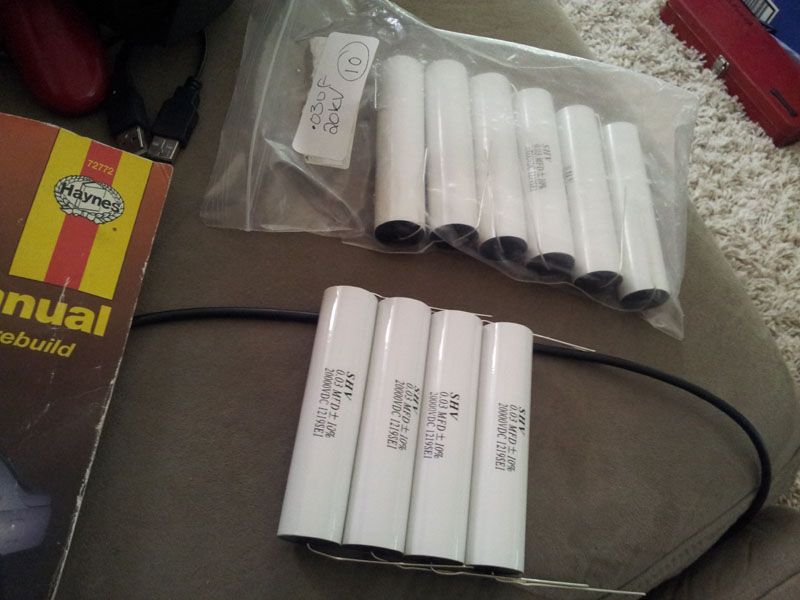I would love to see the plans for that just to stay on the safe side. When I ran the coil in my garage last night my wife had some weird things going on with her laptop inside and it probly has something to do with that. When I build the sg coil for sure I'm going to have a dedicated line run to my house ground point outside. No reason to run something that loud indoors. Lol.
It is pretty simple, really. Capacitors pass AC while blocking DC. The size of the capacitor determines how much impedance it presents to a certain frequency of AC. The trick is to pick a value that presents little impedance to the RF from your TC, but a very high impedance to the mains AC power at 50 or 60Hz. The formula for capacitive reactance (impedance) is 1/(2piFC), where F = frequency in Hz, and C = capacitance in Farads.
In choosing a capacitor for an application there are a lot of things to consider, but foremost you have the voltage ratings, which must never be exceeded, and the polarization (if any). Polarized caps are to be used with DC, or where the DC offset exceeds the amplitude of the AC superimposed on the DC.
For this application, the capacitor will be directly connected to mains, so the DC voltage rating needs to exceed the peak voltage of the mains cycle, and ideally the capacitor's AC voltage rating should exceed the AC Vrms of the mains. To determine the peak voltage of a sine wave multiply the Vrms by 1.414. Now, they make capacitors designed specially for mains connections that are engineered to have failure modes that do not result in fires or explosions, these are Class-Y and Class-X rated. Class Y is for mains to earth or mains to mains, and Class X is for mains to earth only. We'll be using a Class-Y2 rated capacitor with 1.25kV DC and 300Vac ratings since I'm on 120Vrms service.
Here is the capacitor I selected/ordered:
Invalid Request
These caps are only 0.1uF, but Class-Y film caps are hard to find in large values, and quickly get expensive. At this capacitance they will present a 26Kohm impedance to the mains AC power. That means only 4.5mA of 60Hz power will seep through. At 200KHz, the f0 of my large TC, this 0.1uF is only a measly 8ohms, and while you wouldn't want 8ohms between the secondary return and true earth as this would seriously limit the flow of RF current to earth (due to the low voltage and high current output of the secondary return), it works marvelously for the high voltage and low current that the mains wiring in the walls pick up due to capacitive coupling from the toroid. At 750KHz, the frequency of most small form SSTCs with no topload, this capacitor presents a paltry 2ohm impedance. If I were to be running a SGTC or DRSSTC, which operate at much lower frequencies typically, I would want a larger capacitance, on the order of 0.68uF at minimum, perhaps up to 3.3uF or so for a 50KHz coil. *See note below about pulsed coils.
Implementation of the capacitor RF shunts is simple: Simply connect one capacitor between the HOT and Ground lines and another capacitor between the NEUTRAL and Ground lines. A third capacitor (X/Y or X rated) can be added between the HOT and NEUTRAL lines but it is not necessary from my experience. I'll be using a completely plastic project box to enclose the capacitors and connections. I'll use a heavy gauge three prong mains plug and a few inches of 12/3 or 14/3 extension cable for easy connecting and disconnecting from the outlet. Ideally you want one of these at the outlet the tesla coil is plugged in at, one at the outlet where any additional ground connection is made (sink, dedicated line, etc), and one at the outlet where any potentially sensitive equipment is located. You can add as many as you like with no detriment (other than to your wallet).
*Pulsed Coil operation (Staccato VTTC, DRSSTC, ISSTC, OLTC, SGTC) causes RF noise at the pulse frequency, its harmonics, the resonant frequency of the secondary (f0), and wideband noise if there is a spark gap. These lower frequency components will see a larger impedance than the f0 and will not be as effectively filtered out by the capacitor shunts. A typical spectrum for a SGTC will see peaks at the mains frequency and harmonics, the break rate, sever orders of harmonics at both even and odd intervals of the break rate, a continuum of white noise from DC to several GHz, the quarter-wave and half-wave frequencies of the wiring between the SG and primary tank, and the f0 of the coil. This LF section, numerically, would look like: 60Hz, 100Hz, 120Hz, 200Hz, 240Hz, 300Hz, 360Hz, 1KHz, 1.2KHz, etc. All of these noise components will find there way onto the mains but will not see a low impedance path to ground through our shunt capacitors.




